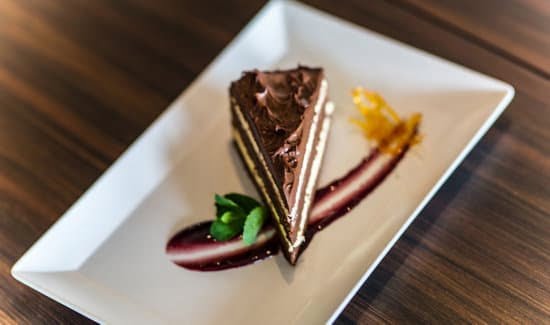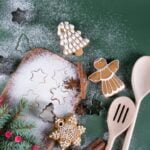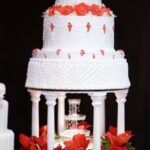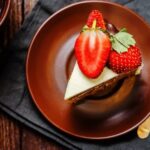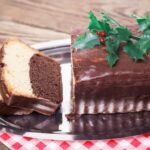Gold color has become a shining star in the world of cake decorating, adding a touch of glamour and elegance to any occasion. From weddings to birthdays, gold is trending as a go-to choice for cake designers looking to create visually stunning masterpieces. In this article, we will dive into the allure and symbolism behind the gold color, discovering why it has captured the hearts of both bakers and cake enthusiasts alike.
It is no surprise that gold holds a special place in our collective imagination. Throughout history, gold has been associated with wealth, luxury, and prestige. Its mesmerizing shine and lustrous appeal make it an ideal choice for celebrating special moments. Whether it is used as a central theme or as subtle accents, gold color elevates any cake design to new heights.
This article aims to unravel the possibilities presented by various shades of gold for cake decorating. We will explore the wide range of hues available, from rich amber tones to soft champagne shades, uncovering how each shade can bring its own unique character and charm to your creations. Additionally, we will provide guidance on choosing the perfect shade of gold that matches your vision and complements the overall aesthetic of your cake design.
Whether you are a professional baker or an enthusiastic home decorator, learning about different techniques and products for achieving a flawless gold finish is key. In the following sections, we will delve into the world of edible gold dust, edible gold leaf, and even non-edible options such as gold spray paint. Through step-by-step guides and expert tips, you will gain valuable insights on how to apply each product effectively to achieve an enchanting golden look.
Join us on this captivating journey into the magical realm of using gold color for cake decorating. From techniques and inspirations to essential tips and tricks, this article promises to inspire both beginners and seasoned decorators alike. So let’s unlock the door to endless possibilities together and embrace the breathtaking magic that gold color brings to cake design.
The Different Shades of Gold for Cake Decorating
When it comes to cake decorating, one of the most captivating and luxurious colors to use is gold. The use of gold color has been trending in recent years, adding a touch of glamour and sophistication to any cake design. From weddings to birthdays, the allure and symbolism behind the gold color make it a popular choice for special occasions.
There are various shades of gold that can be used for cake decorating, each with its own unique characteristics. Some variations include:
- Champagne Gold: This shade of gold has a soft, pale yellow tone resembling the color of champagne. It adds an elegant and subtle touch to cakes, perfect for more delicate or romantic designs.
- Rose Gold: A combination of gold and copper tones creates this warm and rosy shade. Rose gold is trendy and gives a modern, feminine flair to any cake design.
- Antique Gold: With its deep, rich hue reminiscent of antiqued metal, this shade is perfect for creating vintage or rustic cake designs.
When choosing the perfect shade of gold for your cake design, consider factors such as the theme or occasion, the overall color scheme, and personal preference. Take into account whether you want a bright and bold gold or a softer, more muted shade that harmonizes with other elements on the cake.
To achieve these different shades of gold, there are several products available in the market specifically designed for cake decorating. These include:
- Gold dust: Fine particles of edible dust that can be applied dry or mixed with alcohol or extracts for painting or airbrushing.
- Edible gold leaf: Thin sheets made from real gold that can be delicately placed onto cakes for an opulent appearance.
- Gold spray paint: Food-safe aerosol paint that provides quick and even coverage for larger surfaces or intricate details.
Each product requires different techniques for application to achieve a flawless gold finish. Whether you choose dusting, painting with gold leaf, or using spray paint, it is important to follow step-by-step instructions for the best results.
Techniques and Products for Achieving a Gold Finish
When it comes to achieving a luxurious and glamorous gold finish on cakes, there are various techniques and products available that can help you achieve your desired look. Whether you’re aiming for a subtle hint of gold or a bold and shimmering effect, these options will ensure that your cake stands out from the crowd.
One popular product for adding a glittering touch to cakes is gold dust. Made from finely ground edible materials, gold dust can be brushed or dusted onto a cake’s surface to create a beautiful metallic effect. It is important to note that gold dust is usually not water-soluble, so it should be applied dry or mixed with an alcohol-based liquid for best results.
Another option for achieving a stunning gold finish is edible gold leaf. This ultra-thin sheet of real gold can be placed directly onto the surface of the cake to create a smooth and shiny appearance. Edible gold leaf is delicate and requires careful handling, but when applied correctly, it produces an impressive gilded look that will wow your guests.
For those looking for a faster and more convenient method, gold spray paint can be used to achieve a flawless and even coverage of golden color on cakes. Edible spray paint specifically designed for use on food items is available in various shades of gold, allowing you to easily customize the intensity of the color. However, it is essential to ensure that the spray paint is labeled as food-safe before using it on your cake.
To apply these products effectively, follow these general steps:
- Prepare your cake by covering it with a thin layer of icing or fondant.
- If using gold dust, use a soft brush to gently dust or brush the desired areas.
- For edible gold leaf, carefully lift one sheet at a time using tweezers and place it onto the cake’s surface.
- If using gold spray paint, hold the can about 6-8 inches away from the cake and apply a thin and even layer of color.
Remember to always read and follow the instructions provided with each product to achieve the best results. With these techniques and products at your disposal, you can effortlessly create a stunning gold finish that will make your cake an eye-catching centerpiece for any special occasion.
| Product | Technique |
|---|---|
| Gold Dust | Brushing or dusting onto the cake’s surface |
| Edible Gold Leaf | Carefully placing sheets directly onto the cake’s surface |
| Gold Spray Paint | Applying a thin, even layer using food-safe spray paint |
Elevating Your Cake Design with Gold Accents
Creative ideas to incorporate gold accents into your cake design:
- Using gold stencils: Stencils are a fantastic way to add intricate and detailed designs to your cake. To incorporate gold accents, you can use a stencil specifically designed for gold patterns. Simply place the stencil on top of your cake and use edible gold dust or paint to create stunning golden patterns.
- Piped gold details: Piping is a classic technique in cake decorating, and it can be used to create elegant and sophisticated designs with gold accents. Use a piping bag fitted with a small round tip and pipe delicate swirls, scrolls, or other decorative elements onto the cake. You can then dust these piped details with edible gold dust or paint them with edible gold paint.
- Painted gold patterns: If you have an artistic side, painting gold patterns directly onto your cake can be a show-stopping way to incorporate this glamorous color. You can use edible gold paint or thinned-down gel food coloring mixed with lemon extract to achieve the desired shade of gold. Paint geometric shapes, floral motifs, or any other designs that match the theme of your cake.
For all these techniques, it’s important to note that less is often more when it comes to using gold accents on cakes. Gold is such a striking color that even small touches can make a big impact. Therefore, choose areas of the cake where you want the attention drawn and focus on adding subtle yet eye-catching touches of gold.
Additionally, consider pairing the golden accents with other complementary elements such as fresh flowers, ribbon decorations, or even metallic-colored macarons for an extra touch of elegance. The possibilities are endless when it comes to elevating your cake design with the allure of gold accents – let your creativity soar.
Tips and Tricks for Perfectly Applying Gold Color to Cakes
The art of applying gold color to cakes requires careful attention to detail and precision. To achieve a flawless gold finish, here are some helpful tips and tricks:
- Preparing the cake surface: Before applying gold color, it is important to ensure that the cake surface is smooth and free from any imperfections. Use a buttercream or ganache coating to create a solid base for the gold color. Smooth out any unevenness using a palette knife or bench scraper.
- Choosing the right product: There are various products available for achieving a gold finish on cakes, such as gold dust, edible gold leaf, and gold spray paint. Each product provides a different effect and level of shine. Consider the desired outcome and the specific requirements of your design when choosing the product.
- Applying gold dust: Gold dust is commonly used in cake decorating for adding shimmering accents. To apply gold dust, use a soft brush specifically designed for food use. Lightly dip the brush into the dust and tap off any excess before gently brushing it onto the cake’s surface in gentle strokes.
- Using edible gold leaf: Edible gold leaf is another popular option for creating an elegant gold finish. Carefully apply each sheet of gold leaf onto the cake using tweezers or gloves to prevent tearing or wrinkling. Gently press down on the leaf to ensure it adheres properly.
- Avoiding common mistakes: When applying gold color to cakes, there are common mistakes that should be avoided to ensure a seamless result. One mistake is using too much pressure while applying gold dust or edible gold leaf, which can cause smudging or tearing. Another mistake is not allowing enough drying time between layers or coats, leading to uneven coverage.
Taking these tips into consideration will help you achieve a perfectly applied gold color on your cakes, adding an exquisite touch of elegance and sophistication to your designs.
| Tips and Tricks for Perfectly Applying Gold Color to Cakes |
|---|
| 1. Preparing the cake surface: Before applying gold color, it is important to ensure that the cake surface is smooth and free from any imperfections. Use a buttercream or ganache coating to create a solid base for the gold color. Smooth out any unevenness using a palette knife or bench scraper. |
| 2. Choosing the right product: There are various products available for achieving a gold finish on cakes, such as gold dust, edible gold leaf, and gold spray paint. Each product provides a different effect and level of shine. Consider the desired outcome and the specific requirements of your design when choosing the product. |
| 3. Applying gold dust: Gold dust is commonly used in cake decorating for adding shimmering accents. To apply gold dust, use a soft brush specifically designed for food use. Lightly dip the brush into the dust and tap off any excess before gently brushing it onto the cake’s surface in gentle strokes. |
Inspirational Gold Color Cake Designs
Gold color has become increasingly popular in cake decorating, adding a touch of glamour and sophistication to any occasion. From weddings to birthdays, the use of gold color can elevate the overall design and create a stunning focal point. In this section, we will showcase some inspirational cake designs featuring gold color, providing you with ideas that can be adapted to suit any event or theme.
Wedding Cakes
Gold is often associated with luxury and elegance, making it a perfect choice for wedding cakes. One popular design is a tiered cake adorned with intricate gold patterns or delicate lace-like details. These designs create a regal look and add an air of romance to the celebration.
Another stunning idea is incorporating edible gold leaf or gold-painted flowers on a white fondant cake. The contrast between the white base and the shimmering gold accents creates a visually striking effect that is sure to impress guests.
Birthday Cakes
Why not make a birthday cake truly unforgettable by incorporating gold accents into the design? For an adult’s birthday party, consider creating a drip cake with edible gold drips cascading down the sides. This modern and trendy technique takes advantage of the lustrous appeal of gold color.
For children’s birthday parties, you can opt for fun and playful designs. Sprinkle edible gold glitter over cupcakes or use gold-colored icing to pipe whimsical shapes like stars or balloons onto the cake. The golden touches will add a touch of magic to any celebration.
Special Occasion Cakes
Whether it’s an anniversary, graduation, or retirement party, using gold color as part of the cake design can make the occasion even more memorable. Consider incorporating metallic elements such as fondant ribbons or bows in shades of gold for an elegant finishing touch. Alternatively, try using stencils to create intricate patterns on the cake’s surface and then applying gold dust for a shimmering effect.
By experimenting with different cake designs, you can find endless possibilities for incorporating gold color into your creations. Whether you prefer a classic and refined look or a more contemporary and playful design, there are countless ways to embrace the breathtaking magic of gold color in cake decorating.
With these inspirational ideas, you can confidently add a touch of glamour to your next cake creation, exploring the different styles and themes that suit your personal taste and occasion. Don’t shy away from trying new techniques or combinations of colors as you express your creativity through the use of gold color on cakes. Let your imagination run wild as you unlock the enchanting possibilities that this stunning hue brings to the world of cake decorating.
Pairing Gold Color with Other Decorative Elements
When it comes to cake decorating, adding gold accents can instantly elevate the overall design and create a lavish and luxurious look. However, to make the gold color truly shine, it is important to consider how it will interact with other decorative elements on the cake. By strategically pairing gold color with complementary colors and textures, you can create a stunning and cohesive cake that will leave a lasting impression on any occasion.
Exploring Complementary Colors and Textures
To enhance the beauty of gold-adorned cakes, it is essential to choose colors that harmonize well with the golden hue. Complementary colors such as deep burgundy, rich navy blue, or emerald green can create a striking contrast and add depth to your cake design. These jewel tones are known to beautifully complement the warmth of gold.
On the other hand, if you prefer a more understated look, pairing gold color with neutral shades like ivory or blush can create an elegant and sophisticated appearance. Neutral tones offer a soft and delicate backdrop for the golden accents to take center stage.
Texture also plays a vital role in creating visual interest when combining gold color with other decorative elements. For example, incorporating floral elements in bold colors or intricate lace details can add dimension to the design while keeping the focus on the golden accents.
Mixing Gold with Metallics and Jewel Tones
Gold color pairs exceptionally well with other metallic shades like silver or copper. Combining these metallic hues creates a visually stunning contrast that adds glamour and sophistication to your cake design. Whether it’s using silver sequins or copper foil as additional accents, these metallics will enhance the overall look of your golden creation.
For those looking for an opulent feel, mixing gold color with jewel tones such as sapphire blue, amethyst purple or ruby red can be an excellent choice. These vibrant colors create a luxurious and regal atmosphere, while the gold accents add a touch of elegance and magnificence.
Experimenting with Color and Texture
Pairing gold color with other decorative elements allows for endless creative possibilities. Don’t be afraid to experiment with different colors, textures, and patterns to create a unique cake design that reflects your personal style or matches the theme of the occasion. Whether you choose subtle combinations or bold contrasts, remember that pairing gold color with other decorative elements is all about creating a harmonious and visually pleasing cake that will captivate everyone’s attention.
Edible vs Non-Edible Gold Color
When it comes to incorporating gold color into cake decorating, one of the main decisions you will need to make is whether to use edible or non-edible gold color. Each option has its own pros and cons, and understanding them can help you make an informed choice for your cake design.
There are several benefits to using edible gold color in cake decorating. Firstly, it provides a truly luxurious and high-end look to your cakes. The shimmering gold finish is sure to wow your guests and make a statement at any event. Edible gold also adds a touch of elegance and sophistication that is perfect for special occasions like weddings or anniversaries.
In addition to its visual appeal, edible gold also offers the advantage of being safe for consumption. Most edible gold products are made with real gold that is processed in a way that makes it safe for human consumption. This means that if someone eats a slice of cake decorated with edible gold, there will be no harm done.
However, there are some drawbacks to using edible gold color as well. One of the main concerns is the cost. Edible gold tends to be more expensive than non-edible alternatives, which can make it less accessible for some individuals or when working on larger cake projects.
Furthermore, using edible gold requires some additional care and precision during application. It can be delicate and prone to tearing or smudging if not handled properly. This means that achieving a flawless finish with edible gold may require more practice and skill compared to non-edible options.
Ultimately, the choice between edible and non-edible gold color depends on your specific needs and preferences as a cake decorator. If you prioritize an authentic touch of luxury and are willing to invest in quality ingredients, then using edible gold may be the right choice for you. On the other hand, if cost or ease of application is more important, non-edible alternatives can still provide a stunning golden finish without breaking the bank or requiring as much expertise.
Conclusion
In conclusion, the use of gold color in cake decorating has become a trending technique that adds an element of glamour and sophistication to any occasion. The allure and symbolism behind the gold color make it a popular choice for special events such as weddings, birthdays, or anniversaries.
Throughout this article, we have explored the different shades of gold available for cake decorating and how to choose the perfect shade to match your cake design. From subtle champagne tones to bold metallic finishes, there is a wide variety of options to suit every style and theme.
We have also discussed various techniques and products for achieving a flawless gold finish on cakes, including gold dust, edible gold leaf, and gold spray paint. With a step-by-step guide on how to apply each product correctly, you can confidently create stunning golden accents on your cakes.
Additionally, we have provided creative ideas for incorporating gold accents into your cake design. Whether it’s using stencils for intricate patterns, piping details with gold icing, or hand-painting elegant motifs, there are endless possibilities for elevating your cake with the magic of gold color.
To ensure a perfect application of gold color onto your cakes, we have shared essential tips and tricks, such as preparing the cake surface properly and avoiding common mistakes. By following these guidelines, you can achieve a professional-looking result every time.
Lastly, we encourage you to embrace the breathtaking magic of gold color in your cake decorating endeavors. The showcased inspirational cake designs featuring gold color offer limitless possibilities for expressing creativity and bringing enchantment to any celebration.
So go ahead and experiment with different shades of gold, pair it with complementary colors and textures, and don’t be afraid to let your imagination run wild. Whether you choose edible or non-edible forms of gold color, embrace this elegant trend and witness the transformative power that the lustrous hue brings to your cakes. Let the magic unfold.
Frequently Asked Questions
How do you make gold cake color?
To make a gold cake color, there are a few methods you can try. One option is to use gold food coloring specifically made for cake decorating, which is readily available at most baking supply stores. Another approach is to mix yellow and brown food coloring together until you achieve the desired shade of gold.
Start with a small amount of each color and gradually add more until you reach your desired hue. Adjusting the ratio of yellow to brown will allow you to create different variations of gold, from a lighter shade to a deeper, richer tone.
What is the golden color for icing?
The golden color for icing can be achieved using various techniques. One popular method is to use pineapple juice as an ingredient in your icing recipe, as it imparts a natural golden tint to the finished product.
Another approach is to mix yellow and orange food coloring in your icing until you achieve the desired golden shade. Similar to creating gold cake color, start with a small amount of each color and gradually adjust the ratio based on your preferences.
What colors make gold with food coloring?
There are different ways to create gold with food coloring depending on what shades you have available. One common combination involves mixing equal parts of red, green, and yellow food coloring together. This blend produces a warm golden hue when combined properly.
Alternatively, mixing just yellow and brown food coloring can also yield a nice golden shade, especially when using larger amounts of brown compared to yellow for a deeper gold tone. Experimenting with different ratios and combinations will allow you to find the perfect mixture that suits your needs and preferences for creating gold using food coloring.

Welcome to our cake decorating blog! My name is Destiny Flores, and I am the proud owner of a cake decorating business named Cake Karma. Our mission is to provide delicious, beautiful cakes for all occasions. We specialize in creating custom cakes that are tailored specifically to each customer’s individual needs and tastes.

